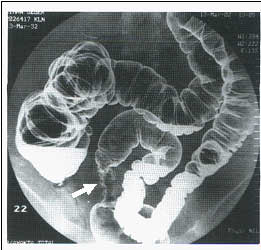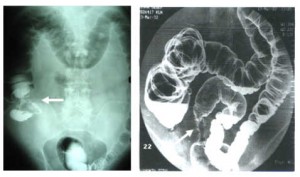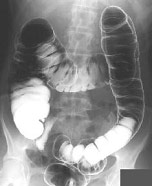Double-Contrast Colon X-ray
Double-Contrast Colon X-ray is a specific test for the large intestine. It is also called a barium enema, double-contrast colon X-ray, or barium colon X-ray. It requires bowel cleansing (enema) the day before the procedure. The total duration is 35 to 45 minutes. After the procedure, patients can resume their daily activities and normal diet.
Double-contrast colon X-ray is a radiographic (X-ray) examination of the lower gastrointestinal (GI) system. The large intestine, including the rectum, becomes visible on X-ray after the colon is filled with a liquid suspension called barium sulfate (barium). Barium highlights certain areas in the body to create clearer images.
What Is A Colon X-ray?
The layer covering the large intestine can be indirectly assessed through a colon X-ray. This test is used to diagnose problems originating from the colon, such as polyps, colitis, tumors, strictures, and diverticula. It is almost as effective as a colonoscopy in detecting large polyps and cancers.
The large intestine is located below the stomach, after the small intestine. Once digested food passes through the large intestine, it is expelled from the body through the rectum. The large intestine is filled with liquid barium through the rectum. Then, images are taken using X-rays.
Barium is an X-ray absorber and appears white on X-ray film. When given rectally, barium coats the inner wall of the large intestine. This allows visualization of the inner mucosal wall, as well as the size, shape, contour, and openness of the colon. This procedure reveals abnormalities not visible on standard X-rays. Barium is only used for diagnostic studies of the GI tract.
The use of barium with standard X-rays contributes to the visibility of various features of the large intestine. Some abnormalities of the large intestine that may be detected with a barium enema include tumors, inflammation, polyps (growths), diverticula (pouches), obstructions, and structural changes in the bowel.
How Do You Prepare For A Double-Contrast Colon X-ray?
The colon must be completely cleaned of stool before the test. This requires prior preparation. You must follow the preparatory instructions given before your test appointment and arrive fasting on the day of the procedure.
Smoking, tea, and cola drinks should be avoided before the test as they may affect the results. The laxative medication you drink as instructed will temporarily cause diarrhea and help empty the bowels. These types of medications may not always be effective with just one use.
Before the procedure, an X-ray may be taken to check if sufficient bowel cleansing has been achieved. In such a case, your specialist may ask you to repeat the medication or recommend a cleansing enema to resolve the issue.
How Is A Double-Contrast Colon X-ray Done?
In the room, you will see an X-ray machine, a long, narrow table, and a television screen. There are two types of barium colon exams: single-contrast and double-contrast. Double-contrast colon examination is generally used for colon cancer screening.
Single-Contrast Colon Examination
The technician inserts a tube into the rectum and attaches the end of the tube to a bag containing the barium solution. The barium is slowly instilled, coating the colon, making it visible.
- As the colon fills with barium, you may feel the urge to defecate. There is a small balloon at the tip of the tube placed in the rectum to administer the barium. After the tube is inserted, the balloon is inflated to prevent barium leakage.
- During the procedure, you may be asked to rotate in different directions on the table. This allows the barium to fill all segments of the colon and enables the colon to be viewed from different angles. You will be asked to hold your breath while the images are taken.
Double-Contrast Colon Examination
- The main difference from the single-contrast test is that the colon is also filled with air, providing better quality images. Smaller lesions, such as polyps, can be easily detected. Although the colon examination usually takes 20-30 minutes, it can rarely extend to 45 minutes. This procedure may cause mild abdominal cramps, but the discomfort resolves as soon as the test ends. After the test, the tube placed in the rectum is removed, and you will be asked to empty your colon. In the days following the test, stools may appear white, gray, or pink due to residual barium. Since leftover barium can cause constipation, it is recommended to drink plenty of water.
- After barium is given rectally, the large intestine is also filled with air. The air appears black on the X-ray film, contrasting with the white appearance of the barium. The use of both barium and air is called a double-contrast study.
- The purpose of using two contrast substances is to enhance the visualization of the inner lining of the large intestine. As air inflates the large intestine (like inflating a balloon), the barium coating the inner surface of the colon wall provides clearer imaging. This technique sharpens the outline of the inner lining of the large intestine and improves the detection of smaller surface abnormalities.



What Is Fluoroscopy?
Fluoroscopy is often used during a barium enema. Fluoroscopy is the study of moving body structures—similar to an X-ray “movie.” A continuous X-ray beam is passed through the body area being examined and transmitted to a TV-like monitor so that the body part and its motion can be seen in detail. In a barium enema, fluoroscopy allows the radiologist to view the movement of the barium through the large intestine as it is administered through the rectum.
Other related procedures that may be used to diagnose lower GI problems include colonoscopy, virtual colonoscopy, abdominal X-ray, abdominal CT (computed tomography) scan, and abdominal ultrasound.
Double-Contrast Colon X-ray Prices 2025
Double-contrast colon X-ray prices vary from region to region and even between institutions in the same area. For information on double-contrast colon X-ray prices, you can call 02126321059.

